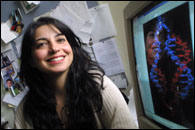Teaching an old DNA new tricks
The double helix is fifty years old -- easily old enough for a mid-life crisis. But the twisty molecule isn't about to buy a sports car and leave its wife for a younger girlfriend. Rather, DNA has decided to experiment with a hip new look, expanding its horizons from the organic to the high-tech. Chemistry professor Hanadi Sleiman is helping with this dramatic transformation.
 Professor Hanadi Sleiman
Professor Hanadi SleimanPHOTO: Owen Egan |
|
When asked why she is so excited about DNA, she replies, "DNA is a smart molecule -- no synthetic compound can rival DNA in intricate structure and precise replication." Her work takes advantage of DNA's structural qualities to build tiny nanomachines to work in our bodies and our electronic gadgets. One day DNA may be equally at home in our computers as in our cells.
In April 1953, Watson and Crick built their famous model of the DNA double helix. Since then, biology's main endeavour has been to read and interpret DNA genetic code, which exists in all living cells, from neurons in our brains to bacteria in our guts. As genome-sequencing projects approach completion, there is renewed interest in the DNA molecule as a physical entity, not an abstract code or so-called book of life.
If DNA is indeed the book of life, Sleiman's philosophy is to rip out the pages and make papier mâché. She aims to build multipurpose mini-machines for use in everything from microchips to human disease diagnosis. It will probably be a few years before DNA nanomachines come into use, but in the meantime Sleiman is busy exploring the boundaries of this new area of study.
A quick look at Sleiman's models shows how much progress has been made since the days of Watson and Crick. Where the original double helix model was built out of wooden balls and sticks, she uses 3D computer graphics to illustrate her DNA structures, which include V-shapes, squares, cubes and stars. Upon closer inspection of the images, a pattern emerges: they are all made up of interconnected strands of the familiar double helix.
"DNA is programmable, and even long strands stay rigid," Sleiman points out. "It is an excellent natural building block." Putting the blocks together is the hard part. Previous attempts relied on floppy connections, incapable of making squares of DNA hold their shape. The problems this entails are obvious -- imagine trying to build a house out of compressible bricks. Both Hanadi Sleiman and colleague Ned Seeman, at New York University, came up with solutions. "Our real advantage is that we use 'unnatural' metal-based corner units, rather than DNA units," says Sleiman. These metal-based corners allow for simplified assembly, come in a plethora of angles, and are fluorescent for quick detection.
Making metal-linked DNA proved to be a relatively simple process, though it's not the sort of project to be undertaken in one's garage. First of all, using Sleiman's technique, you would need to start with a plate of glass 500 angstroms long -- that's one twenty-thousandth of a millimetre. Tiny pores in the glass serve to support the DNA strands, which are built upward from the glass by adding bases (chemical subunits of DNA) one at a time. This results in a forest of tightly packed strands of DNA all standing up next to each other. The last step is to add the metal-containing molecules. Each of these metal compounds can react with two neighbouring DNA strands, linking them together. Voila! A new technique for making branched DNA structures.
Her lab's metal-linkages, the first of their kind in the world, ensure that DNA nanostructures keep their shape. Structures can be further fine-tuned by exploiting different metal hinges. "Our first structure was synthesized using ruthenium, but other metals can be used to create the desired positioning of the strands," explains Sleiman.
Thanks to Sleiman's innovation, DNA nanostructures have taken a giant leap forward along the path to practical applications in medicine and computer engineering. Short strands of radioactively labelled DNA have long been used to detect mutant genes. This works because DNA bases attach to each other in a predictable manner. But the techniques need refining. The detection process is tedious and slightly hazardous because of the radioisotopes involved.
Biologists see Sleiman's metal-branched DNA structures as potentially powerful biosensors. The metal tag is capable of intense fluorescence, making visual identification of abnormal DNA sequences enticingly quick, easy and safe. Better yet, metal-tagged probes save many steps in the procedure of purifying, isolating and identifying genes. For large-scale genomics projects attempting to identify many disease-susceptibility genes all at once, this is especially good news. Sleiman is collaborating with Montreal-based company Galileo Genomics, which aims to use her DNA probes to uncover genetic diseases in Quebec's population.
If any field rivals DNA research for exciting advances it's computer science. Computers rapidly got faster and smaller as bulky vacuum tubes gave way to the silicon microchips that fit so nicely in your PC. But the quest for smallness continues -- and DNA nanostructures may take it to the next level. Sleiman's nanostructure approach could yield much smaller microchips by using the bare minimum number of molecules needed. Squares of DNA would act as a rigid chassis holding the whole thing together.
If viable DNA microchips could be made, it would save the computer industry from an eventual plateau in processor size and speed. Sleiman is working with McGill physicist Peter Grutter, who is trying to find out if the nanostructures are capable of carrying electrical current. "I'm not sure if it will work," muses Sleiman, "but it's never been done before. Even if we find out it doesn't work, that knowledge will still be worthwhile."
McGill's SPARK program (Students Promoting Awareness of Research Knowledge) is funded by NSERC and run by the Faculty of Education, VP Research Office, and the University Relations Office.

